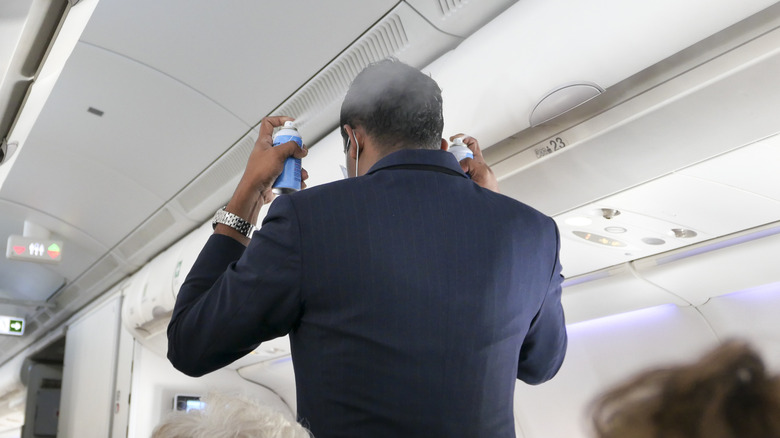Why You Sometimes See Flight Attendants Walking Down The Plane Aisle Spraying Liquid
If you've ever been on a plane, especially during international flights, and seen flight attendants spraying an aerosol can inside the cabin — before allowing you to leave — there is a simple, non-nefarious reason why they do this. They are spraying an insecticide, usually permethrin-based, to kill any pests onboard that may be carrying dangerous diseases or other health hazards. This is because a mosquito carrying malaria could be transported to a country free of the disease and then infect someone there.
Malaria isn't the only disease they're safeguarding from. These health protocols aim to kill insects that could be carrying the Zika virus and yellow fever, too. According to the U.S. Department of Transportation, the practice is an international law intended to protect public health, agriculture, and the environment. The process is called "disinsection." Bug spraying on planes became more commonplace due to the dangers posed by the Zika virus, so it is helpful to know which flights are subject to disinsection before you travel. It is also useful to know the pros and cons of insecticide use, as well as ways to avoid unnecessarily ingesting these chemicals.
Which flights need to be sprayed?
There are different protocols for countries around the world, and not all flights need to be sprayed with disinfectant. Per the Department of Transportation, flights to the Ecuadorian islands, Grenada, Guyana, India, Kiribati, Madagascar, Panama, Seychelles, Tanzania, Timor-Leste, Trinidad and Tobago, Uruguay, and Zimbabwe all require pesticides to be used before arrival, while passengers are still on board. Those coming into Australia, Barbados, Chile, the Cook Islands, Fiji, Jamaica, and New Zealand also require pesticides to be used, but those planes can be disinfected before passengers board.
There are also countries that require spraying for all flights coming from areas where insect-borne diseases, like malaria, Zika, dengue fever, and yellow fever, are present. These are the Czech Republic, Egypt, France, Hong Kong, Indonesia, Italy, Mauritius, Macau, Peru, South Africa, Switzerland, Thailand, and the U.K. If you're traveling between these countries or regions, then you need to be prepared for the likelihood that your flight will be sprayed, to destroy these unwanted stowaways.
Is the insecticide spray toxic?
Some passengers may be concerned that these insecticides could be harmful to human health, and might want to close their eyes while they are being used. It is understandable that people have concerns about pesticides because DDT (dichlorodiphenyltrichloroethane), which was used in the past, was found to be harmful for both humans and animals. The aircraft-specific insecticides made nowadays contain permethrin and are produced in accordance with World Health Organization guidelines. Also, just as you might not want to use bug spray at a campsite, safety regulations require that any bug spray used on a plane must not be flammable, as an aircraft is a pressurized environment.
While WHO reported no health risk from disinsection when done properly, the Centers for Disease Control and Prevention have said that they don't know what the long-term effects of insecticide exposure will be for flight attendants, who use the sprays regularly. They recommend avoiding skin contact with areas that are still wet from pesticide treatment. While it is difficult to quantify the risks of insecticide exposure, it must be balanced with the risks posed by getting an insect-borne disease. When you're on vacation, you could use a DIY bug repellant instead of a store-bought one if you wish to reduce your chemical exposure.


